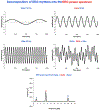Measures of resting state EEG rhythms for clinical trials in Alzheimer's disease: Recommendations of an expert panel
- PMID: 33860614
- PMCID: PMC8647863
- DOI: 10.1002/alz.12311
Measures of resting state EEG rhythms for clinical trials in Alzheimer's disease: Recommendations of an expert panel
Abstract
The Electrophysiology Professional Interest Area (EPIA) and Global Brain Consortium endorsed recommendations on candidate electroencephalography (EEG) measures for Alzheimer's disease (AD) clinical trials. The Panel reviewed the field literature. As most consistent findings, AD patients with mild cognitive impairment and dementia showed abnormalities in peak frequency, power, and "interrelatedness" at posterior alpha (8-12 Hz) and widespread delta (< 4 Hz) and theta (4-8 Hz) rhythms in relation to disease progression and interventions. The following consensus statements were subscribed: (1) Standardization of instructions to patients, resting state EEG (rsEEG) recording methods, and selection of artifact-free rsEEG periods are needed; (2) power density and "interrelatedness" rsEEG measures (e.g., directed transfer function, phase lag index, linear lagged connectivity, etc.) at delta, theta, and alpha frequency bands may be use for stratification of AD patients and monitoring of disease progression and intervention; and (3) international multisectoral initiatives are mandatory for regulatory purposes.
Keywords: Alzheimer's disease; The Alzheimer's Association International Society to Advance Alzheimer's Research and Treatment (ISTAART); biomarkers; clinical trials; dementia; electroencephalography (EEG); eyes-closed resting state condition.
© 2021 the Alzheimer's Association.
Figures




References
-
- Albert MS, DeKosky ST, Dickson D, Dubois B, Feldman HH, Fox NC, Gamst A, Holtzman DM, Jagust WJ, Petersen RC, Snyder PJ, Carrillo MC, Thies B, Phelps CH. The diagnosis of mild cognitive impairment due to Alzheimer's disease: recommendations from the National Institute on Aging-Alzheimer's Association workgroups on diagnostic guidelines for Alzheimer's disease. Alzheimers Dement. 2011. May; 7(3):270–9. - PMC - PubMed
-
- McKhann GM, Knopman DS, Chertkow H, Hyman BT, Jack CR Jr, Kawas CH, Klunk WE, Koroshetz WJ, Manly JJ, Mayeux R, Mohs RC, Morris JC, Rossor MN, Scheltens P, Carrillo MC, Thies B, Weintraub S, Phelps CH. The diagnosis of dementia due to Alzheimer's disease: recommendations from the National Institute on Aging-Alzheimer's Association workgroups on diagnostic guidelines for Alzheimer's disease. Alzheimers Dement. 2011; 7(3):263–9. - PMC - PubMed
-
- Dubois B, Feldman HH, Jacova C, Hampel H, Molinuevo JL, Blennow K, DeKosky ST, Gauthier S, Selkoe D, Bateman R, Cappa S, Crutch S, Engelborghs S, Frisoni GB, Fox NC, Galasko D, Habert MO, Jicha GA, Nordberg A, Pasquier F, Rabinovici G, Robert P, Rowe C, Salloway S, Sarazin M, Epelbaum S, de Souza LC, Vellas B, Visser PJ, Schneider L, Stern Y, Scheltens P, Cummings JL. Advancing research diagnostic criteria for Alzheimer's disease: the IWG-2 criteria. Lancet Neurol. 2014; 13, 614–29. - PubMed
-
- Jack CR, Bennett DA, Blennow K, Carrillo MC, Dunn B, Haeberlein SB, Holtzman DM, Jagust W, Jessen F, Karlawish J, Liu E, Molinuevo JL, Montine T, Phelps C, Rankin KP, Rowe CC, Scheltens P, Siemers E, Snyder HM, Sperling R. NIA-AA Research Framework: Toward a biological definition of Alzheimer's disease. Alzheimers Dement. 2018;14,535–562. - PMC - PubMed
-
- Babiloni C, Barry RJ, Başar E, Blinowska KJ, Cichocki A, Drinkenburg WHIM, Klimesch W, Knight RT, Lopes da Silva F, Nunez P, Oostenveld R, Jeong J, Pascual-Marqui R, Valdes-Sosa P, Hallett M. International Federation of Clinical Neurophysiology (IFCN) - EEG research workgroup: Recommendations on frequency and topographic analysis of resting state EEG rhythms. Part 1: Applications in clinical research studies. Clin Neurophysiol. 2020a. January;131(1):285–307. - PubMed
Publication types
MeSH terms
Grants and funding
LinkOut - more resources
Full Text Sources
Other Literature Sources
Medical
Research Materials

